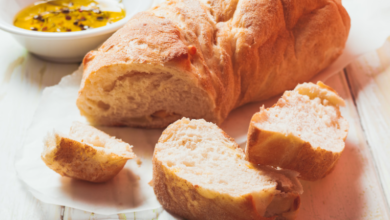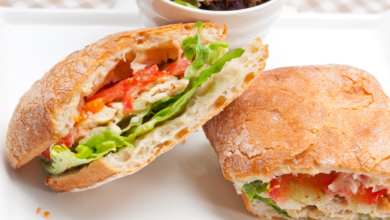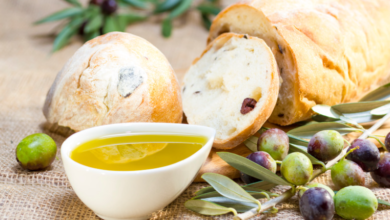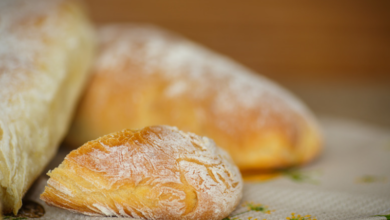Is Ciabatta White Bread? The Surprising Truth

What To Know
- Whole-wheat flour, on the other hand, contains the entire wheat kernel, resulting in a darker bread with a more pronounced nutty flavor and higher fiber content.
- However, white ciabatta has a lower nutritional value compared to whole-wheat ciabatta due to the removal of the bran and germ from the wheat kernels.
- Ciabatta, especially whole-wheat ciabatta, can be considered a healthier bread option due to its higher fiber content and the presence of nutrients found in the wheat germ and bran.
“Is ciabatta white bread?” is a question that has puzzled bread enthusiasts for years. With its airy texture, crispy crust, and distinct flavor, ciabatta stands out from the ordinary. Yet, its classification as white bread remains a topic of debate. In this comprehensive blog post, we will delve into the depths of ciabatta’s composition, exploring its ingredients, characteristics, and nutritional value to answer this enigmatic question.
The Anatomy of Ciabatta: A Closer Look
Ciabatta, originating from Italy, is a type of artisan bread characterized by its large, irregular holes and a chewy, slightly tangy crumb. It is typically made from a mixture of high-quality wheat flour, water, yeast, salt, and sometimes olive oil.
Flour: The Foundation of Ciabatta
The flour used in ciabatta is a crucial determinant of its color and texture. White flour, made from refined wheat grains, produces a lighter-colored bread with a finer crumb. Whole-wheat flour, on the other hand, contains the entire wheat kernel, resulting in a darker bread with a more pronounced nutty flavor and higher fiber content.
Color: A Matter of Perspective
The color of ciabatta can vary depending on the type of flour used. Ciabatta made with white flour will have a pale, almost white color, while whole-wheat ciabatta will exhibit a light brown hue. However, the term “white bread” generally refers to breads made with refined white flour.
Nutritional Value: A Balancing Act
Ciabatta, regardless of its color, is a good source of carbohydrates, providing energy for the body. It also contains moderate amounts of protein, fiber, and vitamins. However, white ciabatta has a lower nutritional value compared to whole-wheat ciabatta due to the removal of the bran and germ from the wheat kernels.
Texture and Flavor: A Sensory Delight
Ciabatta’s unique texture and flavor are attributed to its airy, open crumb and crispy crust. The large holes are created by the use of a high-hydration dough, which allows for the formation of steam during baking. The crispy crust develops as the bread bakes, giving it a distinctive crackling sound when bitten into.
Versatility: A Culinary Canvas
Ciabatta’s versatility makes it a popular choice for a wide range of culinary creations. It can be used to make sandwiches, bruschetta, paninis, and even French toast. Its crispy crust and chewy crumb provide a satisfying contrast in texture that elevates any meal.
So, Is Ciabatta White Bread?
The answer to the question “is ciabatta white bread?” depends on the type of flour used. White ciabatta, made with refined white flour, fits the definition of white bread due to its pale color and lower nutritional value. However, whole-wheat ciabatta, made with unrefined wheat flour, is not considered white bread due to its darker color and higher fiber content.
Recommendations: Ciabatta’s Culinary Enigma Unraveled
Ciabatta, with its distinctive texture, flavor, and versatility, has earned its place as a beloved artisan bread. Whether it is classified as white bread or not depends on the specific ingredients used. White ciabatta, made with white flour, meets the criteria of white bread, while whole-wheat ciabatta, made with whole-wheat flour, does not. Ultimately, the enjoyment of ciabatta lies in its unique characteristics and the culinary possibilities it offers, regardless of its classification.
Questions You May Have
1. What is the difference between white ciabatta and whole-wheat ciabatta?
White ciabatta is made with refined white flour, resulting in a lighter color and lower nutritional value. Whole-wheat ciabatta is made with unrefined whole-wheat flour, giving it a darker color and higher fiber content.
2. Is ciabatta a healthy bread option?
Ciabatta, especially whole-wheat ciabatta, can be considered a healthier bread option due to its higher fiber content and the presence of nutrients found in the wheat germ and bran.
3. What are some popular uses for ciabatta?
Ciabatta is a versatile bread that can be used for a variety of purposes, including sandwiches, bruschetta, paninis, and French toast. Its crispy crust and chewy crumb make it a delightful addition to any meal.





